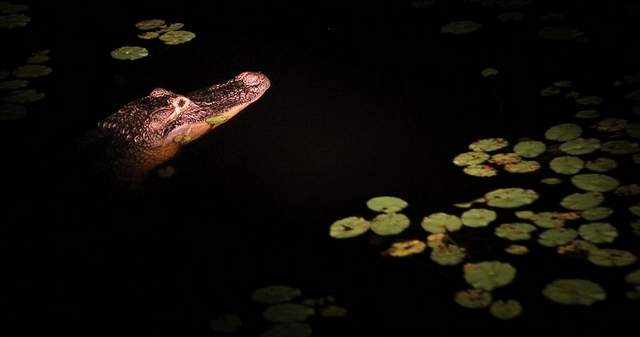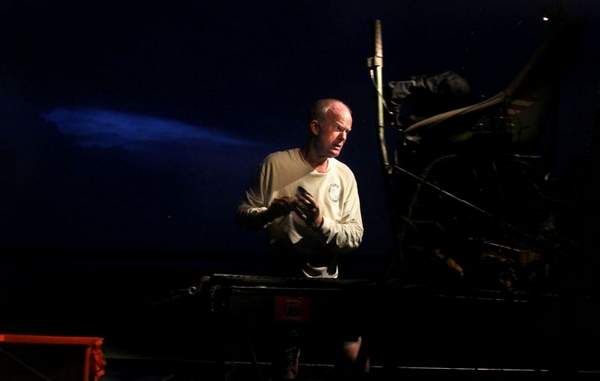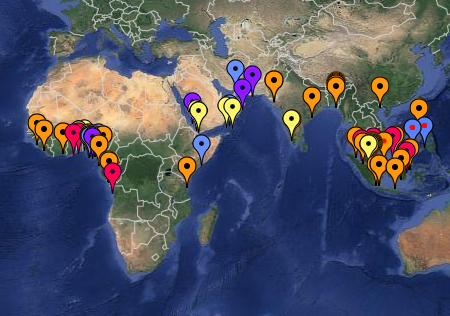state shines light on gator population
by Kevin Lollar
published 4 August 2011
Black silhouettes of cabbage palms and oaks stood against the gray night sky Monday as the airboat roared across Upper Myakka Lake at 15 miles per hour.
A powerful hand-held spotlight swept from side to side to illuminate the eerie red eye-shine of alligators in the water, among the emergent vegetation and on the shoreline.
Holding the spotlight with one hand and steering the boat with the other, Lindsey Hord, head of Florida’s Alligator Management Program, called out the size classes — estimated size in feet — of each animal:
“One 6 to 7, one 5 to 6, two 1 to 2, one 8 to 9,” he said, calculating each alligator’s length from up to 30 yards away.

An American alligator is illuminated by a spotlight from the airboat of Lendsey Hord, a biologist with Florida Fish and Wildlife Conservation, during a nighttime alligator count Monday at Myakka River State Park.
Hord was counting alligators as part of the Florida Fish and Wildlife Conservation Commission’s statewide alligator monitoring program, which dates back to 1974.
Every spring and summer, FWC researchers conduct surveys in more than 100 water bodies throughout the state. Most are in alligator management units, where recreational alligator hunting is allowed during four harvest periods that begin Aug. 15 and end Sept. 12. No hunting is allowed on Upper Myakka Lake, which is in Myakka River State Park.
“The more we do surveys, the more powerful our statistics are; the closer to the truth we’re going to be,” Hord said. “A snapshot of the population doesn’t tell you anything.
“We hear people saying there aren’t enough alligators. Or we hear from legislators that there are too many alligators. If you don’t know what the population is, it’s hard to make management decisions.”
Idling away from the park’s ramp, Hord marked the survey’s start time, 2055 hours (8:55 p.m.), and flew out across the lake.
Rather than running transects, Hord cruised around, seemingly on a random course.
When the spotlight picked up the red reflection of an alligator’s eyes, Hord made straight for it, sometimes bringing the boat within inches of the animal’s head.
“I’m familiar with the lake,” said Hord, who has been counting Florida’s alligators for 33 years. “I can see eyes at 300 yards. It’s a matter of keeping track of the ones I’ve counted so I don’t double-count.”
Calculating alligator lengths at 15 mph is part guesswork.
“It’s not a perfect science,” Hord said. “It’s a subjective call. That’s why it’s good to have the same person count the same place every year. Whatever bias there is is consistent.”
Almost wiped out
During the 1950s and 1960s, commercial harvest almost wiped out the wild alligator population, and the U.S. Fish and Wildlife Service listed the species as endangered in 1967 under a law that preceded the Endangered Species Act.
Populations rebounded (the Florida population is about 1.3 million), and the alligator was reclassified as threatened due to similarity of appearance to the endangered American crocodile.
Florida started a recreational alligator harvest in 1988, and the annual alligator surveys are a way to make sure recreational quotas are not too large to sustain the population.
“Since we started the statewide harvest, most populations have increased,” FWC wildlife biologist Arnold Brunell said. “We’ve had a few areas where they’ve declined, possibly due to harvest. If surveys show declines, we cut back on harvest quotas.”
Bad place to tip over
Flying along the north shore of the lake, Hord saw red eye-shine in the vegetation and moved in for a closer look. He estimated the animal at 10 to 11 feet.

Lendsey Hord, a biologist with Florida Fish and Wildlife Conservation, prepares his airboat Monday for a nighttime alligator count at Myakka River State Park.
“Whoa,” he said. “That’s a big one. We don’t want to tip over here. If we tip over, we want to do it by a 1- to 2- footer.”
After surveying the lake, Hord drove the boat down the Myakka River to the State Road 72 bridge and then ran back to the ramp — end time 2150 (9:50 p.m.).
Near the ramp, a 10-foot alligator, unperturbed by the spotlight, repeatedly snapped its jaws to gobble tiny fish that swam and jumped around its head.
“Seems like a waste of energy to catch minnows,” Hord said. “But who knows what goes on in the mind of an alligator?”
For the night, Hord counted 143 alligators, normal for this time of year.
But why so much concern about an animal that was once considered a pest?
For one thing, Brunell said, it’s a keystone species, which means its presence is essential to its ecosystem.
For example, alligators create depressions in the mud. During dry periods, these gator holes hold water, and many other species use them for breeding and drinking. As apex predators, alligators keep populations of other species in check.
“From an economic standpoint, alligators fascinate people,” Brunell said. “The presence of alligators has a significant impact on tourism: Most people want to see gators when they’re here.
“This is a high profile animal in our state. It’s an important critter.”


